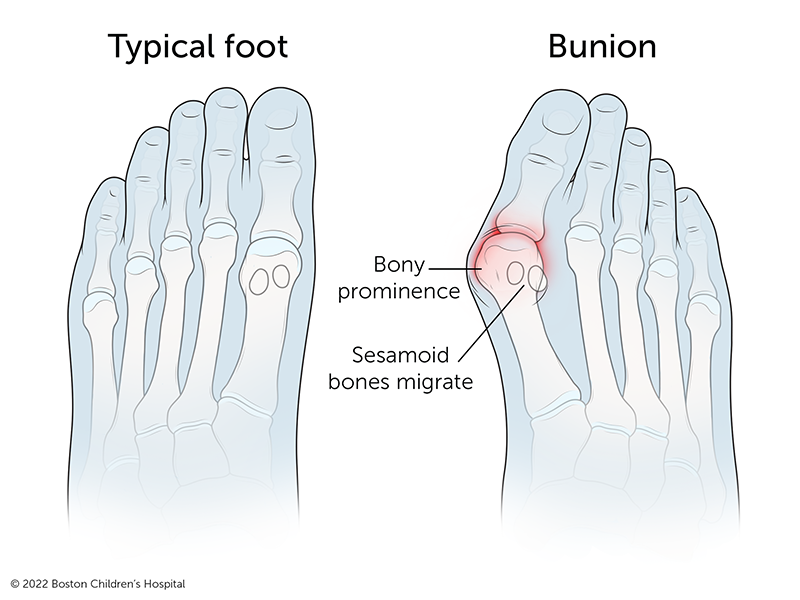Bunions | Symptoms & Causes
What causes bunions?
The exact cause of bunions is unknown. In adolescents, bunions are often an inherited family trait.
Some conditions, such as cerebral palsy and Down syndrome, increase a child’s risk of having bunions.
In adults, tight shoes that squeeze the toes together can increase the risk of developing bunions, but this is rarely the cause in children.
What are the symptoms of bunions?
Symptoms of adolescent bunions vary depending on how severe they are. While most bunions are not painful, symptoms can include:
- redness and swelling at the base of the big toe
- a sore bump at the base of the big toe
- pain and trouble wearing shoes
- pain when walking
Bunion symptoms may resemble other conditions or medical problems. Always consult your child's physician for a diagnosis.
Bunions | Diagnosis & Treatments
How are bunions diagnosed?
Your child should be evaluated by a pediatric orthopedic specialist. The doctor will ask about your child’s medical history and perform a careful physical examination of your child. This will involve observing your child's:
- foot alignment
- weight-bearing alignment
- walking and running gait
- mobility of the affected toe joint
The surgeon will also want to know what kind of shoes your child wears and what types of shoes aggravate the symptoms. They will try to determine whether any pain caused by the bunion is due to specific activities, and whether the bunion is causing any functional limitations.
X-ray imaging may be used to help determine the extent of the damage and deformity of the toe joint.

A new option for teens with painful bunions
In the rare cases that bunions require surgery, patients experience less pain and recover faster thanks to a new minimally invasive procedure. Orthopedic surgeon Dr. Collin May explains.
How are bunions treated?
Well-fitting shoes
Most bunions, particularly in teenagers, can be managed without surgery. The first step is often replacing tight shoes with shoes that don’t press against the bunions or cause your child pain when they walk. Your child's orthopedic surgeon can give you information about the types of shoes and proper shoe fit. Here are some general rules for selecting shoes:
- Have your both of your child's feet measured regularly and select shoes that fit the larger foot.
- Select shoes based on how they fit your child's foot, particularly the width of the forefoot.
- Make sure the ball of your child's foot fits well into the widest part of the shoe.
- Make sure your child's heels fit comfortably in the shoes, with little or no slippage.
- Have your child walk around the store in the shoes to make sure they are comfortable to walk in.
- Do not purchase tight shoes hoping they will stretch over time.
Some shoes (and skates or ski boots) can be made more comfortable by stretching the areas that put pressure on your child's big toes.
Your child should wear their well-fitting shoes all the time. Switching back to poorly fitting shoes that squeeze the toes will be painful and could increase the risk that your child’s bunions will become larger and more painful.
Your child's orthopedic surgeon may recommend splints to reposition the big toe and special shoe inserts (orthotics). Orthotics are padding shaped to your child’s feet to help relieve pain from bunions.
Surgery
Surgery is not recommended for teenagers with bunions unless they have first replaced poorly fitting shoes, are using an orthotic, or both. If they still have severe foot pain that limits their everyday activities, surgery may be an option.
The goal of surgery is to relieve pain and correct the deformity. Surgery for cosmetic reasons alone is not recommended.
Some of the most common bunion surgeries include:
- Traditional bunion correction. The bones around the toe joint are surgically cut and repositioned. They are held in place with screws or a metal plate and screws while the bone heals.
- Minimally invasive bunion surgery. This procedure is similar to traditional bunion correction in that the bone is cut and repositioned. However, the incisions are much smaller and patients typically recover more quickly.
- Repair of tendons and ligaments. The tendons and ligaments surrounding the big toe may be tight on one side and loose on the other. This imbalance pulls the big toe toward the smaller toes. The procedure to correct this shortens the loose tissues and straightens the tight tissues. It is often combined with an osteotomy in traditional bunion correction.
- Exostectomy. The bump on the toe joint is surgically removed. This procedure is only used if the bone is enlarged but the big toe position is normal.
How we care for bunions
The Lower Extremity Program at Boston Children's Hospital offers comprehensive assessment, diagnosis, and treatment for children of all ages with bunions and other conditions affecting their lower limbs. We have extensive experience treating disorders of the feet, ankles, knees, legs, and hips. Whether the patient is an infant, child, or adolescent, our goal is to help children live full, independent lives.



